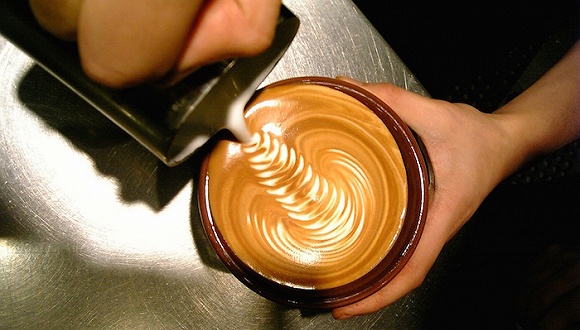The expression of alcohol and strength in the analysis of coffee components

For coffee, the touch of the mouth and palate comes from water-insoluble liquid components-fatty oils, and water-insoluble solids-sediments suspended in coffee water after brewing. In addition to providing texture for the overall taste of coffee, suspended matter in coffee also affects the taste of coffee by forming colloids.
1. Fatty oil
Raw coffee beans contain 7% Mel 17% fat, which is produced in coffee trees and stored in coffee beans to provide nutrients for the germination of coffee beans. Vegetable fat usually turns into oil when it is higher than room temperature. These oils are often used as cooking oil.
Coffee oil plays a subtle and important role in the overall taste of coffee. First of all, because the coffee oil droplets are suspended on the coffee water, it reduces the surface tension of the coffee water, which makes the coffee taste smooth and creamy. Second, these coffee oils carry other flavored compounds, just as animal fats are the main carriers of woody smoke in these foods in the smell of ham and cheese. Similarly, coffee fat is also the carrier of various special taste components of coffee. After the coffee has been kept for too long, the hydrogenation and oxidation of fat will affect the taste of the coffee, just as the butter will become salty when placed in an overheated and damp environment.
2. Precipitate
An undissolved solid substance or sediment that comes from two pipes.
First, a small amount of coffee fiber is washed down from the surface of coffee powder and suspended in water. Under the action of gravity, tiny coffee fiber particles precipitated to the bottom of the cup.
Second, insoluble substances are water-insoluble proteins. These proteins come from amino acids in raw coffee beans. In the process of baking, amino acids combine with each other to form larger molecules to form proteins. Finally, these protein molecules become so large that they cannot be dissolved in water. These proteins eventually produce coffee "dirt", which accumulates more and more, eventually forming a layer of dark, oily sediment on the coffee brewing equipment.
3. Coffee gum
The oil suspended in coffee water combines with the sediment to form coffee gum. This colloid is oily under natural conditions. They help form the texture of coffee, just as water vapor in the atmosphere combines with floating dust to form smoke clouds. As a colloid, it absorbs and absorbs the taste of other substances, which has an important effect on enhancing the taste of coffee.
During adsorption, these colloids stick to a thin layer of aromatic compounds, leaving the gases in the coffee liquid until the coffee is swallowed. Under the action of absorption function, colloid acts as a buffer, weakening the intensity of acid. The formation of gum in coffee is the main reason why the taste of fresh coffee is different from that of instant coffee. When evaluating a cup of coffee, the traditional preparation process greatly retains the colloid content in the coffee.
Filtering coffee with coffee filter paper will filter out most of the colloidal particles in the coffee. However, if the particles are less than 1 microunit (mu), they can pass through most coffee filters. Continuous heating can also destroy the stability of coffee gum. Gravity separates the colloidal particles, forming an oily layer on the surface of the coffee water and a precipitate at the bottom of the cup. The result is that when coffee is directly heated for any period of time, the taste will be changed due to the separation of coffee gum.
4. Alcohol degree and strength
A systematic description of the taste of coffee includes a description of its "mellowness". Mellowness is a measure of the touch of the nerve endings in the mouth to the liquid and solid suspensions suspended in the coffee. "mellowness" should be distinguished from "strength". Strength is a measure of the quantity and variety of soluble components in coffee. Intensity gives coffee a taste, while mellow gives coffee a taste. It is possible to make a full-bodied cup of coffee with a weak taste.
5. Taste terminology
(1) Alcohol degree (body)
The physical properties of the drink. The texture of the skin in the tongue and mouth during and after drinking the coffee.
(2) Butter (buttery)
The results show that there are more oily suspended solids in coffee. Most coffee brewed under pressure, such as espresso, often has this taste. Under the action of pressure, the oil in the soybean fiber is fully extracted.
(3) creamy creamy
Caused by certain oily substances suspended in coffee. Creamy is produced because there is a lot of fat in raw coffee beans.
(4) heavy
Describe the mellowness of coffee. High concentration indicates that there are more than medium amounts of solid suspensions in coffee-small particles of coffee fiber and large amounts of insoluble proteins.
(5) Light (light)
Describe the mellowness of coffee. It indicates that there are low and medium amounts of solid suspended matter in coffee. This situation is usually related to the low ratio of coffee to water when making coffee.
(6) smooth
Caused by low and medium amounts of oily substances suspended in coffee. It is the result of a moderate amount of fat in raw beans.
(7) thick
There is a feeling caused by a relatively large number of solid suspensions in coffee. Espresso often has this characteristic. This is the result of the existence of a large number of soybean fiber particles and insoluble proteins.
(8) thin
There is a feeling caused by a relatively small amount of solid suspension in coffee. It is the result of a small number of coffee fiber particles and insoluble proteins. This happens when making coffee with filter paper because the proportion of coffee to water is too low.
(9) Water smell (watery)
The feeling caused by less oily suspended matter in coffee. Only a small amount of fat in raw beans will produce such a result. Coffee made from a very low coffee-to-water ratio often has this characteristic.
Important Notice :
前街咖啡 FrontStreet Coffee has moved to new addredd:
FrontStreet Coffee Address: 315,Donghua East Road,GuangZhou
Tel:020 38364473
- Prev

The standard of coffee taste describes the type of dry aroma.
1. Olfaction (sense of smell): each kind of coffee has a unique smell (bouquet), which distinguishes coffee from different producing areas or species. A, Dry aroma/ fragrance- dry aroma; coffee grinding before brewing coffee dry powder aroma B, Cup aroma/ aroma- wet aroma; coffee brewing, the aroma emitted from the liquid surface C,
- Next

Several practical principles for judging coffee how to express the flavor of coffee
The first rule to judge coffee is: clean when light and even cleaner when strong. It's like a room, it's easy to be clean when it's empty, but it has to be clean when it's full. The second principle for judging coffee is that [spindle taste] represents the characteristics of this producing area. Cleanliness is the foundation. An unclean cup of coffee represents flaws, but clean coffee.
Related
- Detailed explanation of Jadeite planting Land in Panamanian Jadeite Manor introduction to the grading system of Jadeite competitive bidding, Red bid, Green bid and Rose Summer
- Story of Coffee planting in Brenka region of Costa Rica Stonehenge Manor anaerobic heavy honey treatment of flavor mouth
- What's on the barrel of Blue Mountain Coffee beans?
- Can American coffee also pull flowers? How to use hot American style to pull out a good-looking pattern?
- Can you make a cold extract with coffee beans? What is the right proportion for cold-extracted coffee formula?
- Indonesian PWN Gold Mandrine Coffee Origin Features Flavor How to Chong? Mandolin coffee is American.
- A brief introduction to the flavor characteristics of Brazilian yellow bourbon coffee beans
- What is the effect of different water quality on the flavor of cold-extracted coffee? What kind of water is best for brewing coffee?
- Why do you think of Rose Summer whenever you mention Panamanian coffee?
- Introduction to the characteristics of authentic blue mountain coffee bean producing areas? What is the CIB Coffee Authority in Jamaica?

